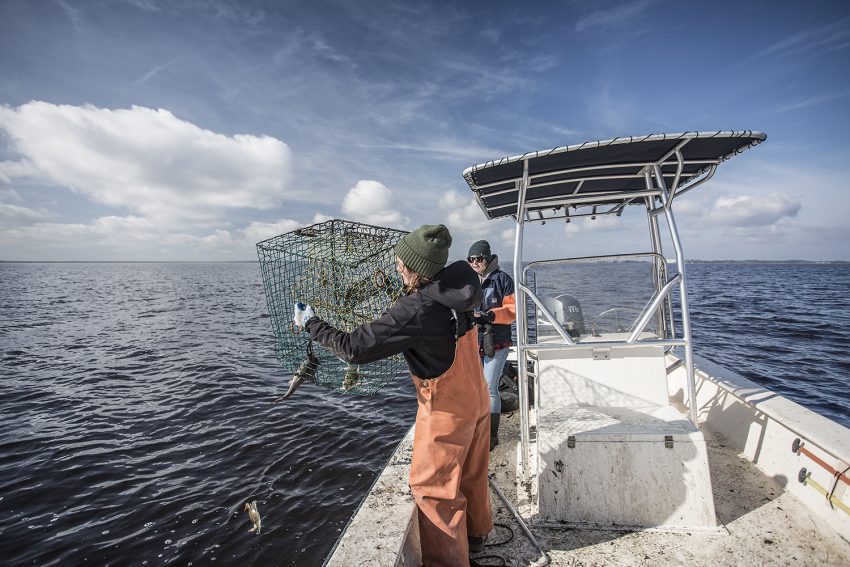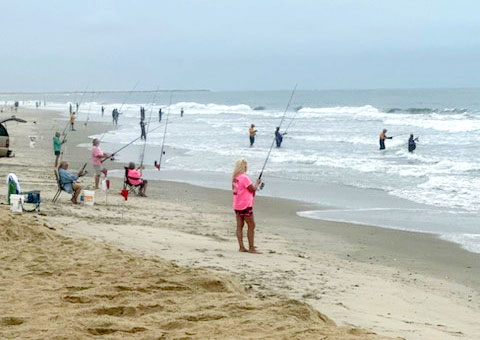Tensions run high at four-hour meeting on cobia closure By JOY CRIST
On Monday evening, May 9, the South Atlantic Fishery Management Council, in conjunction with the Mid-Atlantic Fishery Management Council, held a public question-and-answer meeting to address cobia management issues, including an upcoming closure of the fishery, at the Hilton Garden Inn in Kitty Hawk.
The meeting was attended by roughly 50 people at the site, as well as 60 to 70 attendees who tuned in via an online webinar.
The recreational fishery for Atlantic migratory group cobia is scheduled to close on June 20. The closure applies to those fishing for cobia recreationally in federal waters from Georgia to New York from a private vessel, charter vessel, or headboat.
In North Carolina, the federal waters’ jurisdiction extends from 3 miles to 200 nautical miles offshore, although the inshore North Carolina state waters mirror the NOAA fisheries restrictions.
The scheduled recreational closure has caused concerns from fishermen, particularly those from North Carolina and Virginia, where the closure will have negative economic and social impacts because of the seasonality of the fishery.
As a result, tensions and tempers of the attendees were high and continued to rise for the more than four hour duration of the meeting.
In between public comments, the council made five presentations which outlined the following:
Essentially, the 2016 season closure is due to accountability measures required by federal regulations in the amended Magnuson-Stevens Fishery Management Act to protect the cobia resource and prevent overfishing.
The 2015 recreational catch was 1,540,775 pounds, which was well over the recreational annual catch limit (ACL) of 690,000 pounds. This annual catch limit is set from the Georgia-Florida border to New York state. The East Florida-Gulf region, which had a recreational ACL of 830,000, was under its limit with a total of 372,118 pounds.
The attendees, who were a mix of commercial fishermen, charter boat captains from North Carolina and Virginia, and even fishing pier owners, had a number of issues with multiple facets of the closure and cobia management.
The participants were well-versed on the subject – utilizing language from the Magnuson-Stevens Fishery Management Act, and at one point even university-conducted studies, to make their points – and the council answered questions as best as they could or promised to direct information to the proper channels.
And as dozens of questions and comments were vocalized throughout the evening, there were a few running themes that highlighted the fishing community’s top concerns.
DISPROPORTIONATE EFFECT OF CLOSURE
One issue that was raised several times was how a June 20 closure will affect North Carolina, and especially Virginia, as their cobia seasons start much later than the more southern states.
“Ninety percent of our season in Virginia is going to be gone,” said a Virginia representative.
One speaker noted that the closure was especially hard for pier owners, as pier fishermen typically don’t start seeing cobia until after the closure is in effect.
“This is going to decimate the pier livelihood, because it’s a huge part of the pier income, and the cobia don’t hit the pier until summer,” said the speaker. “The pier guys are not going to get anything at all.”
“How is a singular accountability measure that is an end of season closure not discriminatory against the states at the end of the migratory pattern?” asked another speaker. “This seems like a clear violation of National Standard 4. The fact that the negative impact is directly proportional to the amount of representation present on the council is problematic.”
THE ACCURACY OF THE DATA
One of the biggest issues for attendees was the accuracy, or potential inaccuracy, of the recreational data. Many speakers stated that they had never been checked or had not seen surveyors on the fishing docks. The council stated that it was an angler-based survey.
“I’ve been cobia fishing for 10 year and have been checked maybe twice in those years and don’t know anyone that has been checked in the last five years,” said one webinar attendee.
“There is no way feasible we could have reached this limit,” said a public commenter. “The people in this room are the contenders. I have never been surveyed. We throw them on the dock, and nobody’s been checking. I personally don’t know one person who has been checking.”
This concern about the data belied a greater concern that the cobia season closures would continue to become even stricter in the years to come. The anglers present at the meeting, who are in the water constantly, did not believe that the data backed up what they saw first-hand on a daily basis.
“This is why we are so skeptical of log books and data collection,” said one fishermen, who relayed how over the years he had continued to see plenty of red snapper, even as the seasons were getting shorter. “Four years ago there was a nine-day season for red snapper. The following year was three days, the next was one day, and the following year was none. Why do we want to help you with data when we prove without a shadow of a doubt that the [population isn’t changing?] The cobia season could go this same direction.”
ECONOMIC IMPACT STUDY
Another major concern for several speakers was the lack of an economic impact study of a season closure.
“Has there been an economic impact study done as required by Magnuson-Stevens Fishery Management Act?” asked one speaker, “Or are you just going to ignore this… and not follow your own rules?”
“An economic study was done in amendment 12, but what wasn’t analyzed was if the season got shortened,” replied Gregg Waugh, executive director of the South Atlantic Fishery Management Council.
“If you all feel these impacts are too much, you have the ability to sue. That’s a route,” he said. “The council is doing everything we can to change this – but we can’t do anything for this year.”
Multiple frustrations were brought to light through dozens of comments as the meeting went on.
“If we catch them, they’re saying it’s being overfished, and if we don’t catch them at all, the population is down,” said one commenter.
“Frankly, Gregg, I wouldn’t trust you if your tongue was notarized,” said webinar participant Jonathan French.
And out-of-the-box solutions were considered and proposed by the participants.
“You need to contact your senators,” advised a Virginia fishermen. “That’s what we did in Virginia. We started contacting our state senators and saying we’re losing thousands of dollars every year, and now they’re listening. That’s what you need to do here.”
The evening concluded with the final presentation and an overview of possible long-term solutions and short-term solutions for the following year.
The council asked the crowd if changing the vessel and/or bag limit was a possibility, but anglers agreed that reducing the limit would exacerbate the problem.
“Catch and release isn’t going to cut it,” said one charter boat captain. “If I have six people on a boat, and they’re paying $1,200, catch and release isn’t going to be worth their money.”
Other potential solutions involved separating the allocation by state, but the council recognized that it could take a while to implement.
“We could also do state-by-state allocation, but that’s going to take more time. The council recognizes the big differential and we’re working to fix that.”
Other potential solutions for 2017 and beyond included:
Anglers are encouraged to make any public comments for the upcoming SARMC June meeting by May 20. The meeting will be held June 13-17 at Cocoa Beach. Fla., and the public can also speak at the meeting itself.
In June, the South Atlantic Council will review public input and make changes to the amendment, so the public is encouraged to get their comments in. The eventual preferred alternatives will be approved in September for formal review by the secretary of Commerce, and will go into effect in spring 2017.
Public comments must be received in the council office by 5 p.m. on May 20. Comments may be submitted by mail, email, or fax:







